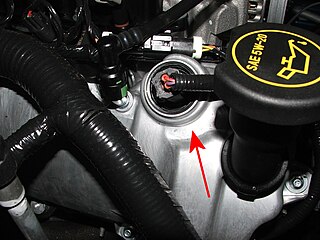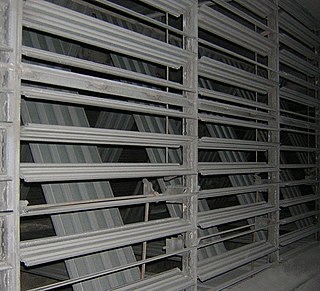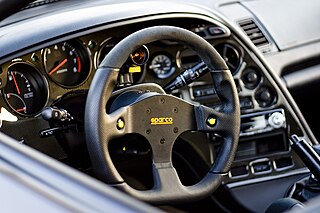
A valve is a device or natural object that regulates, directs or controls the flow of a fluid by opening, closing, or partially obstructing various passageways. Valves are technically fittings, but are usually discussed as a separate category. In an open valve, fluid flows in a direction from higher pressure to lower pressure. The word is derived from the Latin valva, the moving part of a door, in turn from volvere, to turn, roll.

An automatic transmission is a multi-speed transmission used in motor vehicles that does not require any input from the driver to change forward gears under normal driving conditions. Vehicles with internal combustion engines, unlike electric vehicles, require the engine to operate in a narrow range of rates of rotation, requiring a gearbox, operated manually or automatically, to drive the wheels over a wide range of speeds.

Fluid power is the use of fluids under pressure to generate, control, and transmit power. Fluid power is conventionally subdivided into hydraulics and pneumatics. Although steam is also a fluid, steam power is usually classified separately from fluid power. Compressed-air and water-pressure systems were once used to transmit power from a central source to industrial users over extended geographic areas; fluid power systems today are usually within a single building or mobile machine.

VTEC is a system developed by Honda to improve the volumetric efficiency of a four-stroke internal combustion engine, resulting in higher performance at high RPM, and lower fuel consumption at low RPM. The VTEC system uses two camshaft profiles and hydraulically selects between profiles. It was invented by Honda engineer Ikuo Kajitani. It is distinctly different from standard VVT systems which change only the valve timings and do not change the camshaft profile or valve lift in any way.

Variable camshaft timing (VCT) is an automobile variable valve timing technology developed by Ford. It allows for more optimum engine performance, reduced emissions, and increased fuel efficiency compared to engines with fixed camshafts. It uses electronically controlled hydraulic valves that direct high pressure engine oil into the camshaft phaser cavity. These oil control solenoids are bolted into the cylinder heads towards the front of the engine near the camshaft phasers. The powertrain control module (PCM) transmits a signal to the solenoids to move a valve spool that regulates the flow of oil to the phaser cavity. The phaser cavity changes the valve timing by rotating the camshaft slightly from its initial orientation, which results in the camshaft timing being advanced. The PCM adjusts the camshaft timing depending on factors such as engine load and RPM.
Active Fuel Management is a trademarked name for the automobile variable displacement technology from General Motors. It allows a V6 or V8 engine to "turn off" half of the cylinders under light-load conditions to improve fuel economy. Estimated performance on EPA tests shows a 5.5–7.5% improvement in fuel economy.

Hydraulic machines use liquid fluid power to perform work. Heavy construction vehicles are a common example. In this type of machine, hydraulic fluid is pumped to various hydraulic motors and hydraulic cylinders throughout the machine and becomes pressurized according to the resistance present. The fluid is controlled directly or automatically by control valves and distributed through hoses, tubes, or pipes.

A damper is a valve or plate that stops or regulates the flow of air inside a duct, chimney, VAV box, air handler, or other air-handling equipment. A damper may be used to cut off central air conditioning to an unused room, or to regulate it for room-by-room temperature and climate control - for example, in the case of Volume Control Dampers. Its operation can be manual or automatic. Manual dampers are turned by a handle on the outside of a duct. Automatic dampers are used to regulate airflow constantly and are operated by electric or pneumatic motors, in turn controlled by a thermostat or building automation system. Automatic or motorized dampers may also be controlled by a solenoid, and the degree of air-flow calibrated, perhaps according to signals from the thermostat going to the actuator of the damper in order to modulate the flow of air-conditioned air in order to effect climate control.

A solenoid valve is an electromechanically operated valve.

An air-operated valve, also known as a pneumatic valve, is a type of power-operated pipe valve that uses air pressure to perform a function similar to a solenoid. As air pressure is increased, the compressed air starts to push against the piston or diaphragm walls which causes the valve to actuate. Whether the valve opens or closes depends on the application. These valves are used for many functions in pneumatic systems, but most often serve one of two functions. The first activates a part of the system when a specific pressure is reached. The second prevents damage by maintaining a constant pressure or flow rate inside a system, or releasing pressure when it reaches excessive levels.
The RFE is an automatic transmission family from Chrysler. The name refers to its Rear wheel drive design and Full Electronic control system.
A transmission control unit (TCU), also known as a transmission control module (TCM), or a gearbox control unit (GCU), is a type of automotive ECU that is used to control electronic automatic transmissions. Similar systems are used in conjunction with various semi-automatic transmissions, purely for clutch automation and actuation. A TCU in a modern automatic transmission generally uses sensors from the vehicle, as well as data provided by the engine control unit (ECU), to calculate how and when to change gears in the vehicle for optimum performance, fuel economy and shift quality.
In turbocharged internal combustion engines, a boost controller is a device sometimes used to increase the boost pressure produced by the turbocharger. It achieves this by reducing the boost pressure seen by the wastegate.

In drag racing, a transbrake is a mechanism that selectively places the transmission in a forward and reverse gear simultaneously. This allows the engine to create full power without transmitting that power through the driveline, allowing the car to stay in one place.
A variable force solenoid (VFS) is an electro-hydraulic device that controls pressure proportionally or inversely proportionally to a signal obtained from the on-board controller of a powertrain. A low flow VFS is used as a signal level devices for transmission line pressure control or application of clutches. A high flow VFS controls line pressure directly or are used for direct shift clutch control. A VFS is a type of Transmission Solenoid. One or more VFS can be used in an automatic transmission or installed in an automatic transmission valve body.
A pneumatic circuit is an interconnected set of components that convert compressed gas into mechanical work. In the normal sense of the term, the circuit must include a compressor or compressor-fed tank.
A shutdown valve is an actuated valve designed to stop the flow of a hazardous fluid upon the detection of a dangerous event. This provides protection against possible harm to people, equipment or the environment. Shutdown valves form part of a safety instrumented system. The process of providing automated safety protection upon the detection of a hazardous event is called functional safety.

MultiAir or Multiair is a hydraulically-actuated variable valve timing (VVT) and variable valve lift (VVL) engine technology enabling "cylinder by cylinder, stroke by stroke" control of intake air directly via a gasoline engine's inlet valves. Developed by Fiat Powertrain Technologies, the technology addresses a primary engine inefficiency: pumping losses caused by restricting intake passage by the throttle plate that regulates air feeding the cylinders.
Variable valve timing (VVT) is a system for varying the valve opening of an internal combustion engine. This allows the engine to deliver high power, but also to work tractably and efficiently at low power. There are many systems for VVT, which involve changing either the relative timing, duration or opening of the engine's inlet and exhaust valves.
In engineering, a solenoid is a device that converts electrical energy to mechanical energy, using an electromagnet formed from a coil of wire. The device creates a magnetic field from electric current, and uses the magnetic field to create linear motion.










